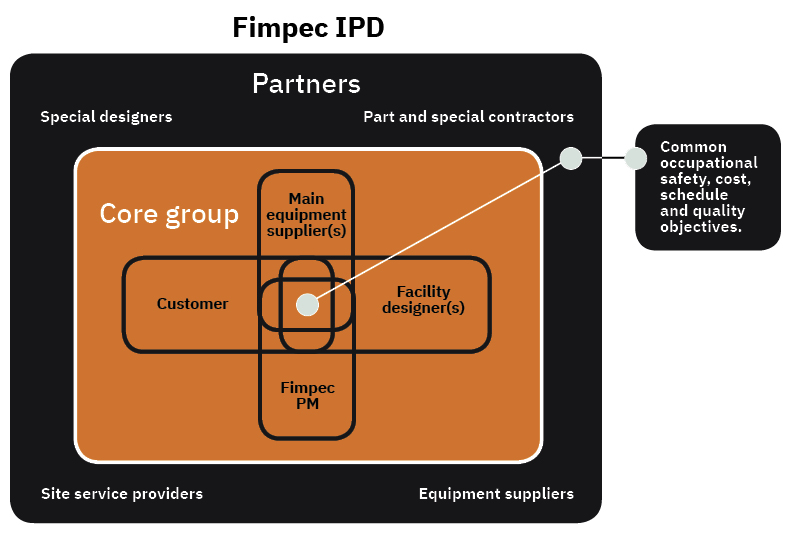Projects flow with the help of Fimpec IPD and Lean

Fimpec IPD and Lean bring real added value to our clients’ projects and make functions open and effective.
IPD i.e. Integrated Project Delivery is a project organization model. It forms a joint project team between the customer and other key players and sets common goals for the team. Each actor enters into their own agreement with the customer, but the roles and responsibilities are assigned individuals best suited to them, regardless of company boundaries.
Fimpec applies its own Fimpec IPD model in its projects. The main difference between Fimpec IPD and the traditional IPD implementation model is in particular the approach that Fimpec has developed for the industrial sector, which intensifies the project organisation’s cooperation at an early stage of the project. Eelon Lappalainen, Fimpec’s construction and design manager, says that in Finland, the traditional concept of IPD is rooted in alliance projects, which aim to commit key players to common goals and better cooperation through agreements.
“However, Fimpec IPD has emerged from industrial investment projects in collaboration with industrial companies. It has been developed especially for these projects. In the Fimpec model, co-operation starts at a very early stage, often already at different project and pre-study stages. The seed of cooperation is then sown with the customer’s team. We start towards common goals well in advance of the investment decision. At Fimpec’s IPD, it is essential that occupational safety, cost, schedule and quality targets are set together with the customer and that Fimpec has a truly “skin in the game” mentality”, Lappalainen describes.
Fimpec has successfully utilized IPD in numerous projects. The benefits of the IPD model have been seen especially in Metsä Group’s bioproduct plant projects in Kemi and Äänekoski. The lessons learned from the Äänekoski project have been further developed in Kemi with the customer, and the parties responsible for the plant’s design have also been involved in more in-depth cooperation. In both bioproduct factory projects, a joint project team consisting of key actors was built already in the project planning phase.
Fimpec IPD strives to ensure that important customer goals are met. Lappalainen says that in industrial projects, it is especially important that one’s own investment is launched safely, with high quality, on budget and on schedule.
“For example, it is often important for industrial customers to have a reliable cost estimate and schedule based on knowledge of similar projects. Fimpec is a particularly strong expert here, because since the establishment of the company, post-calculation and scheduling information for industrial projects have been systematically collected and we always utilize this information in our customers’ projects. In addition, Fimpec IPD has clear policies for the different phases of the project. In particular, to manage the demanding interface between construction and installation, the company has ready-made and tested operating models. In this case, the work can proceed smoothly, and the client can focus on things that are important to them”, Lappalainen sums up.
IPD is based on improving flow efficiency in a Lean manner
The concept of IPD has emerged in the language of project activities through Lean. The Lean operating philosophy is based on improving flow efficiency. This is done by trying to remove obstacles to the flow of work through different methods and to reduce the waste of work that arises in different activities.
Tatu Kivinen, Fimpec’s design engineer, says that the core principle of Lean operations is to identify the added value and progress of the work. In Lean, it is important to identify what is actually valuable and, on the other hand, what hinders the work. Because of this one key feature is that the work is visualized in order to be able to anticipate future tasks and their conditions.
Another key principle in Lean is to limit unfinished work. A project becomes more flow efficient by focusing on essential tasks instead of increasing workflow. The third key principle of Lean is that work should not be done separately from others, but in open collaboration.
Kivinen describes that at its best, Lean brings the customer a more reliable delivery, where schedules are met, and operations are transparent to the customer. For employees, Lean is a motivating principle that brings a sense of success through a model of continuous learning and development.
Lean thinking has great potential in expert work, although it is not such a tangible model of action. However, the entire work community from management to employees needs to engage in Lean so that it integrates properly into everyday work. Lean is actually more of a culture or philosophy than just one strategy of action”, Kivinen explains.
Fimpec IPD and Lean provide the keys to project success
At Fimpec, Lean and IPD are implemented through skilled experts. Employees have experienced first-hand how Lean methods are useful in everyday project work. The company has grown strongly in recent years, but Lappalainen says that he has noticed that new employees are also adopting Lean methods in projects alongside older “veterans”. At Fimpec, Lean has been integrated into operations and has also had management support from the beginning.
In the case of Lean construction, one of the most common ways of organizing large and demanding projects is the IPD. Lappalainen explains that the traditional model, in which the actors sub-optimize their own business separately and manage the project mainly through contracts, is the opposite of IPD. Projects can be promoted in the same way, but such a model is no longer enough to manage the increasingly fast-paced and demanding projects in industry. This creates a need for an IPD-like approach.
“The pursuit of better flow efficiency is, of course, a kind of ideal that is never achieved, but without direction, operations do not develop. I am very confident that we will be able to incorporate Lean methods and Fimpec IPD in our new Metsä Group’s Kemi bioproduct plant project for our new employees, contractor representatives, equipment suppliers and that our customers will benefit from the methods we use. In this way, we will continue to ensure cooperation and the continuous development of our IPD model to meet the needs of our customers”, Lappalainen emphasizes.


